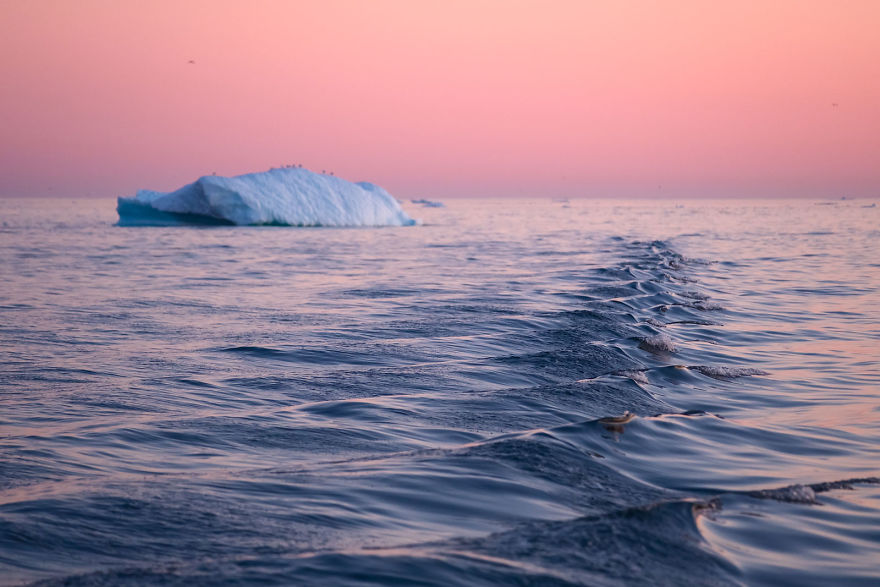
I Photographed A Place In Greenland Which Is Known For Its Countless Icebergs
I come from the land of Nomads. Born in the Russian Far East and raised in Southern Kazakhstan, I became a nomad myself. I am immensely grateful to have the opportunity to travel the world and capture its Nature and people through photography.
I’ve been going to Greenland for years, and one of my favorite towns to visit is Ilulissat, famous for its surreal landscapes, where small colorful houses are surrounded by countless icebergs.
There is one area there that I find particularly attractive – Ilulissat Icefjord. In the summertime, I love coming there at around midnight, sitting down with a thermos full of hot coffee and listening to the icebergs calving while they are making their way into the ocean.
Allow me to share my amazement with this place through the images below.
More info: Instagram
Greenland’s Ilulissat Icefjord
Located on the west coast of Greenland, 250 km north of the Arctic Circle, it is a tidal fjord covered with floating brash and massive ice
It is situated where the Sermeq Kujalleq glacier calves ice into the sea.
Sermeq Kujalleq is also one of the fastest moving (40 m per day) and most active glaciers in the world
Icebergs breaking from the glacier are often so large – up to a kilometer (3,300 ft) in height – that they are too tall to float down the fjord and lie stuck on the bottom of its shallower areas
Sometimes they lie there for years, until they are broken up by the force of the glacier and icebergs further up the fjord.
Surreal colours of Midnight Sun in Ilulissat Icefjord
On breaking up the icebergs emerge into the open sea and initially travel north with ocean currents before turning south and running into the Atlantic Ocean.
Larger icebergs typically do not melt until they reach 40-45 degrees north – further south than the United Kingdom and level with New York City
I was born in the Russian Far East. Even though I never lived there, you can say that cold and darkness are in my blood! I grew up with my mother’s stories about indigenous peoples of the north, their traditions and tales. When I grew up and had a chance to discover the Arctic there was no turning back, I forever fell in love with the frozen landscapes and magical skies filled with Northern Lights.
However, there are some challenges I have to overcome when traveling around the arctic region. I love having control, it gives me comfort and a sense of security. Not being able to control my surroundings often brings me anxiety. When you are traveling and exploring new places and new cultures, control is the last thing you have. Especially in the Arctic. This is definitely a challenge but a positive one. Learning how to just sit back and focus on observing the world is a skill I hope to keep developing throughout my life.
The Icefjord at around 1am in summertime
Whales are often seen feeding in the area
Moon rising over “parked” icebergs
Sermeq Kujalleq is a very productive glacier
It annually calves over 35 km3 of ice, i.e. 10% of the production of all Greenland calf ice and more than any other glacier outside Antarctica.
Ilulissat Icefjord is a UNESCO World Heritage Site
The combination of a huge ice sheet and the dramatic sounds of a fast-moving glacial ice-stream calving into a fjord full of icebergs make for a dramatic and awe-inspiring natural phenomenon.
My next project is a multi-media study of the effects of climate change on the Arctic. I am using my vast library of images from Iceland, Greenland and Norway and combining them with 3D renders of ice, water and fire simulations. While writing this I realize how vague it sounds. I guess I will have to hurry up and finish it so that I can show you the results!
8Kviews
Share on FacebookHi Caitlin, thank you for your kind words! It's my favourite place to come with a thermos in summer, sit down and just listen to the ice breaking...
Load More Replies...These are great photos! Do you have any insight as to what effect global warming is having on the area?
Hi Jef, thank you for your kind words. Oh, I can talk about that forever. The ice doesn't freeze the way it used to, it forces locals to change their lifestyle. They can't travel the same routes as before in winter (what before was frozen is now water, even in January). Polar bears show up in settlements they way they never did before because they can't find food in their usual habitat. The glaciers are melting at unprecedented rate... and so on and so on
Load More Replies...Hi Caitlin, thank you for your kind words! It's my favourite place to come with a thermos in summer, sit down and just listen to the ice breaking...
Load More Replies...These are great photos! Do you have any insight as to what effect global warming is having on the area?
Hi Jef, thank you for your kind words. Oh, I can talk about that forever. The ice doesn't freeze the way it used to, it forces locals to change their lifestyle. They can't travel the same routes as before in winter (what before was frozen is now water, even in January). Polar bears show up in settlements they way they never did before because they can't find food in their usual habitat. The glaciers are melting at unprecedented rate... and so on and so on
Load More Replies...
 Dark Mode
Dark Mode 

 No fees, cancel anytime
No fees, cancel anytime 





























































243
24